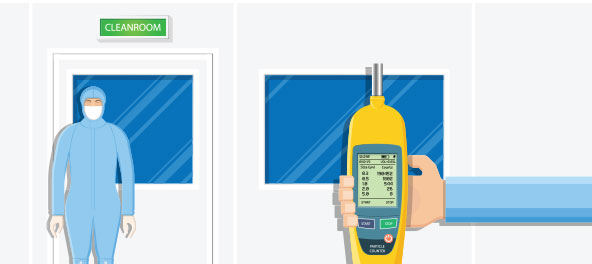Looking for an affordable alternative to a permanent cleanroom? Portable cleanrooms (also called modular cleanrooms) are usually constructed with a rigid frame such as steel and have panels made from plastic, vinyl or clear flat materials.
They offer many of the benefits of a permanent cleanroom, but with the added versatility of being movable and more affordable. Portable cleanrooms can also be expanded when needed.
Portable cleanrooms might not be the perfect permanent solutions for most organizations, but they offer a lot of benefits over building a traditional cleanrooms.
What Makes Portable Cleanrooms Different
Like traditional cleanrooms, they are designed to use HEPA filters and provide a clean workspace, but they offer additional benefits, such as:
- Movability. A true portable cleanroom is often built on wheels, so they can be moved easily.
- Affordability. Because they do not require extensive infrastructure, they are typically more affordable than static cleanrooms.
- Versatility. Portable cleanrooms can be moved, adjusted, expanded, and changed, as the organization’s needs shift.
- Customization. You can customize a portable cleanroom to fit into just about any area or ceiling height. You are also able to add and remove components as needed (for example, you might need an antechamber or you might not).
Ultimately, portable cleanrooms are the affordable, versatile solution for sudden surges in demand and production or for start-ups that do not have the funds to build traditional Static cleanrooms.
How Portable Cleanrooms Are Constructed
When constructing your portable cleanroom, it is critical to maintain sanitation as you put it up. It is also important to choose a portable cleanroom made up of easily sanitized and cleaned materials – although most manufacturers should abide by best practices in this regard.
You will need to start with the framework. Portable cleanrooms will use a sturdy frame in which prefabricated panels can be hung from within hours. Although the panels are prefabricated, they can be custom made to fit your specific needs.
You will also need to properly install the LED lights and HEPA filters. These filters are what makes your cleanroom an actual cleanroom – not just a room made out of plastic walls. Therefore, it is critical that you follow manufacturer instructions when installing them. These items can often be kitted from your portable cleanroom vendor.
If you added an ancillary products to your cleanroom, such as a gowning chamber (also called an anteroom), you will want to make sure that you have this mapped into your set-up.
You will also want to address the floor of your cleanroom. Depending on your set-up and ISO classification, you might have a perforated raised floor, seamless vinyl, rubber flooring or simply epoxy paint. Either way you will want to make sure the floor, you are placing the portable cleanroom on a floor that is non-porous and easily sanitized.
Who Uses Portable Cleanrooms
Any industry that uses cleanrooms could benefit from a portable cleanroom!
- Pharmaceuticals
While pharmaceuticals are typically manufactured in the cleanroom, portable cleanrooms offer quick, easily erected solutions to production issues or additional necessary research. For instance, when a worldwide pandemic hits, and extra space is suddenly needed to produce and research vaccines, treatments, etc., then a portable cleanroom is a viable solution. - Technology
Are you reading this on a phone or computer? Then at least a portion of the device you are using was developed in a cleanroom! As technology companies need to quickly shift and adapt, they could benefit from portable cleanrooms – especially for tech start-ups. - Manufacturing
Similar to technology production, manufacturers will occasionally need to increase their capacity. In that case, they will need a quick and affordable solution to a space problem. Expanding established permanent cleanrooms will not be an option (and potentially unnecessary if the surge in demand is temporary), so portable cleanrooms can be the solution. - Food Production
Food production is ever changing and flexing, so when demand suddenly rises, cleanrooms will need to shift to allow for more packaging and production. Just like with manufacturing and technology, portable cleanrooms are the affordable solution. Food production regulations are usually less stringent than pharmaceuticals but they have similar contamination concerns such as mold and bacteria in the air.
How to Measure Particles In A Portable Cleanroom
It’s still important to keep a portable cleanroom clean – and make sure it stays that way. So you still need to monitor for particles.
There are three main types of particle counters: remote, handheld, and portable particle counters.
If your portable cleanroom is moved very often, setting up a remote particle counter system may not be practical. And a handheld particle counter may not offer the scope that might be required.
So we typically recommend a portable particle counter in a modular cleanroom setup.
Portable particle counters are designed ergonomically to be user friendly AND movable. They offer a lot of flexibility and options, so they can integrate into a number of systems. But they don’t require the infrastructure that remote particle counters need. They create their own vacuum and read samples quickly.
With the options that come with portable particle counters, they are usually the right solution for a modular cleanroom.
If you’re curious which portable particle counter is right for you and your portable cleanroom, let’s chat and find you a solution.


